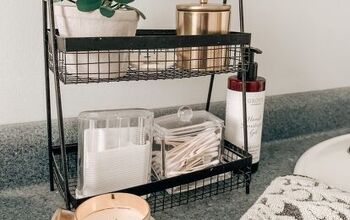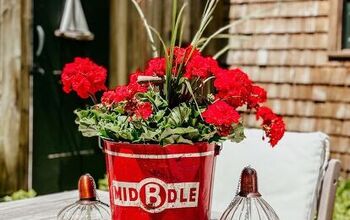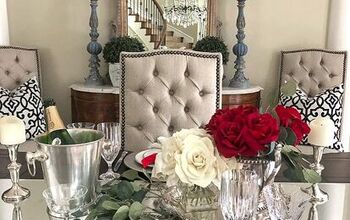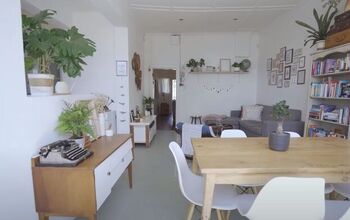When You're Decorating a House Here's Where to Start

When decorating a house, where to start is the most common dilemma. I'm an interior designer, store owner, and educator. Today, we are going to talk about how to begin decorating your space.
These principles I'm going to talk about are the foundations of a good design. If you understand these three principles and apply them correctly, your efforts will be successful.
Declutter
This applies to those who are redecorating or refreshing a space. Clutter is a significant roadblock when it comes to decorating. Joshua Becker said the first step in crafting the life you want is to get rid of everything you don't. I tell my clients all the time that we really cannot begin until the clutter is taken care of.
I know it can be challenging. There are many reasons you may be dealing with clutter. Perhaps you have kids, or you've inherited a lot of things from a parent who has passed, and you can't let go of it because of the memories attached. Do not beat yourself up for having clutter. It happens, but recognize it and come up with some solutions to that issue.
Here are a few simple ways I help keep clutter at bay or hidden. One way that I keep clutter off of my nightstand is in my top drawer. I have these little boxes with dividers. So I've got my glasses, any medicine, lotion, air pods, anything I need, and it's sectioned off, kept organized, and my nightstand looks clutter-free.
Another way that I keep my home clutter-free is in my office. I also have these different storage containers.
I have different ones that have drawers and different ones that open, but this really helps me keep organized.
Maybe you need a drawer by the door to hold your mail and keys as a dropping station. Maybe you need baskets for your kids' toys. Whatever it may be, do some thinking about solutions to your clutter and establish new habits to avoid things piling up.
Maybe you have too much decor. This counts as clutter as well. Do you have too many photo frames and knickknacks sitting around? In order to create a new space, you're really going to need to consider letting go of most of those items.
With photo frames, I suggest creating a gallery wall somewhere.
This is a great way to display those photos without so many different photo frames cluttering up a table, top, or bookcase.
The big thing is being willing to let go of things that don't absolutely bring you joy, represent who you are today, or have sentimental meaning to you.
Understand layering
Layers are the elements that make up your design, such as paint, furniture, textiles, etc. These items must be selected in the correct order because it is a domino effect. It's like the children's book: if you give a mouse a cookie, he will probably want some milk to go with it.
Well, if you change the paint in a room, you're probably going to need a new rug to go with it, so it's essential to know where to begin.
For the most part, I recommend starting with the largest items in the room.
An example of that would be if you have a newly built home with the floors and paint already finished but have nothing else in the bedroom. Well, the bed! It's going to be the first thing you choose. Then, there are the other pieces of furniture, textiles, accessories, etc.
Another example would be if you had a bedroom where you already had all the furniture, but you hated the paint and textiles. Well, then, your most significant layer would be the paint.
Then, you choose the textiles like drapes, area rugs, and bedding that coordinate well with the paint color.
Everyone's situation has a different set of circumstances and requires a different starting point. Here's my rule of thumb: anything that falls under the construction umbrella must be done first.
Paint, wallpaper, flooring, tile work, and cabinetry all must be done first. It is your first layer. Why? Because the rest of the design choices hinge on the outcome of those projects and choices.
For instance, if you know you want to paint the room and change the flooring, it would be out of order to purchase a rug first.
You need to select the proper layers in order. Start with the larger skill items and focal points and move down to the details.
Plan your cohesive details
Cohesiveness is achieved when all the elements come together in a design. This can be done by recognizing a color in a fabric pattern, using the same color in the artwork, and then echoing a familiar color in the rug. That ties everything together, and when done correctly, your space should feel intentional.
Now, a few good rules to abide by are these wood tones being no more than two kinds, metals being no more than two finishes, and for colors, be sure to keep them in the same family. There are, of course, exceptions to these rules, but for the most part, I do recommend sticking within those parameters.
Now, why are details important? Well, the details are the characteristics of your chosen elements. Think of the patina of a light fixture, the fringe of a pillow, the frame of the artwork, and furniture hardware. These details need to come together, or your design will fall flat. For a polished and perfected design, do not overlook the details.
Coordinated details provide a room unity but, when ignored, can make a room feel aimless. Pay attention to the details. Consider how you could tie together items to achieve that cohesiveness we talked about.
I recommend making a mood board, which will be a visual display of your choices. This will show you how well your design flows. It's funny; sometimes I think something will look absolutely perfect in the design, but then I place it in the mood board, and it just jumps out at me as not being correct at all.
So, place your selected items in a mood board to really see how cohesive your design will be.
Decorating a house: where to start
I hope these three tips answer your question about "decorating a house, to start?" When you get rid of the clutter, it gives you a blank space to work with, and when you assess the proper layers needed, you will avoid making mistakes.
When you plan out your details, they will all come together for an intentional and cohesive look. I hope these tips have been helpful for you. Share your decorating plans in the comments below; I'd love to hear from you!
























Comments
Join the conversation